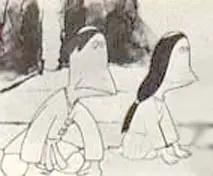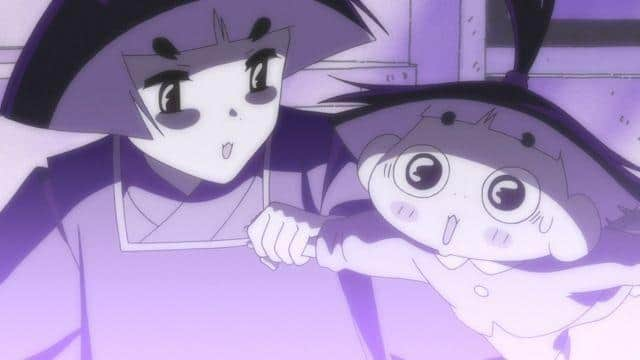Non-Fiction Hour: The Birth of Japan - Appreciated for its fusion of realistic historical depiction and entertainment

"Nonfiction Hour: The Birth of Japan": The appeal of anime depicting the history and culture of ancient JapanOverview"Nonfiction Hour: The Birth of Japan" is an anime series that aired on Nippon Television in 1970. Although it is short, consisting of five episodes, each of which is 17 minutes long, it depicts the history and culture of ancient Japan. This anime is an original work that tells the story of the development of Japanese civilization in a documentary style, with an anthropomorphized kappa as the main character. ■ StoryRyufa, a male kappa living in southern China, meets Kozara, a female kappa who washed ashore from Japan. This encounter leads Ryufa to introduce cultures such as rice cultivation and iron tools to Kyushu. This has a major impact on Japanese civilization, which develops rapidly. Ryufa, a kappa who will live for 1000 years, continues to observe the history of Japan from the Kofun period to the Taika Reforms. ■ExplanationThis anime has a strong documentary feel, depicting the development of ancient Japan with an anthropomorphized kappa as the main character. Under the guidance of Dr. Masao Nagaoka, director of the Institute for Languages of Asia and Africa, the show combines fiction and live-action footage to explore mysterious themes such as the origins of the lifestyle and culture of ancient Japanese history and the establishment of the ancient nation. The combination of animation and live-action footage provides viewers with a realistic historical experience. ■CastThe narrator is Mizuho Suzuki, and the voice actors include Koji Nanbara, Sakiko Ozawa (Sumie Ozawa), Reiko Niimura, Hiroyuki Sugi, Naoko Yusa, Sohei Kurata, Minoru Hirano, and others. These voice actors bring the kappa characters to life. ■ Main staffThe characters are by Baba Noboru, and the director is Yamamoto Eiichi. Storyboards and key animation are by Hata Masami and Seyama Yoshifumi, music by Tomita Isao, art by Tomita Miho, photography by Haraya Tateo, Nomiyama Tsutomu, Honda Takeshi, sound by Aketagawa Susumu, editing by Ito Akira, production assistant by Nozaki Yoshihiro, production manager by Shimozaki Hiroshi, sound effects by Ishida Sound, and producers by Ushiyama Junichi and Ikeuchi Tatsuo. KLM Royal Dutch Airlines is also in charge of production. ■ Main CharactersRyufa is a young male kappa from southern China who spread rice cultivation and iron tools to Kyushu. Kappas live for 1000 years, so they witness everything from the Kofun period to the Taika Reforms. Meanwhile, Kozara is a female Japanese kappa who washed up on land in China and was rescued by Ryufa. Through her relationship with Kozara, Ryufa decided to introduce Chinese civilization to Japan. ■SubtitleThe subtitles of each episode are as follows:
■ Evaluation and impressions"Nonfiction Hour: The Birth of Japan" is a unique anime that depicts the history and culture of ancient Japan. By featuring an anthropomorphized kappa as the main character, the show allows viewers to learn about history in a familiar and interesting way. It also offers a realistic historical experience through its documentary-style structure and use of live-action footage. In particular, the story that begins with Ryufa and Kozara's encounter leaves a deep impression on viewers. Ryufa's gaze as a 1000-year-old kappa on the history of Japan is deeply moving and leaves a deep impression on viewers. The subtitles of each episode are also interesting and have the power to draw viewers in. The cast and staff are also luxurious, and in particular, Isao Tomita's music enhances the atmosphere of the work. Baba Noboru's character is also attractive, creating a character that is loved by viewers. In addition, the cooperation of KLM Royal Dutch Airlines has improved the quality of the work. ■RecommendationThis anime is recommended for history buffs and general viewers alike. Through the personified kappa, you can learn about Japanese history and culture. The documentary-style structure and use of live-action footage also provide a realistic historical experience. In particular, the story that begins with the meeting between Ryufa and Kozara is deeply moving and leaves a deep impression on the viewer. In addition, the cast and staff are also luxurious. In particular, Isao Tomita's music and Noboru Baba's character enhance the appeal of the work. The quality of the work is also improved with the cooperation of KLM Royal Dutch Airlines. Please watch this anime and enjoy the history and culture of ancient Japan. ■ Additional informationThis anime was broadcast in 1970, so it may be difficult to watch it now. However, if you can find it on DVD or online, please give it a try. Also, since the original work of this anime is an original anime, it is not related to other works, but if you watch other works that depict the history and culture of ancient Japan, you will be able to understand it more deeply. In addition, by featuring an anthropomorphized kappa as the main character, this anime allows viewers to learn history in an easy-to-understand and interesting way. In particular, the story that begins with Ryufa and Kozara's encounter is deeply moving and leaves a deep impression on viewers. Please watch this anime and enjoy the history and culture of ancient Japan. |
<<: Review of "Misuke in Ice Country": A moving story and beautiful visuals
Recommend
Japanese manga artist Shimabukuro Mitsutoshi launches new manga "BUILD KING" after 4 years
Japanese manga artist Shimabukuro Mitsurugi has b...
P1S Movie "Bumblebee" Dark Decepticon Optimus Prime Statue Priced at $1,849
Recently, the famous model manufacturer Prime1Stu...
"G.I. Joe" expands the storyline of the sequel "Snake Eyes" and is in preparation
Although it has not been officially released yet,...
Yowamushi Pedal NEW GENERATION Season 3: A thorough evaluation of the challenges and growth of the new generation
The appeal and evaluation of the third season of ...
Goddess in white! Angelina Jolie appears on the set of Marvel's "Eternals"
The new Marvel superhero film "Eternals"...
The cover image of Marvel x Tsuburaya's "Ultraman Rise" comic is released and will be released in September this year
The main cover image of the new Ultraman comic st...
"Saint Seiya" live-action movie new trailer Phoenix Ikki's domineering appearance
Today (March 8), the new official trailer for the...
A short trailer announced the new animation project of "Sword Art Online: Attack on Titan"
Aniplex's official Weibo account recently upd...
The appeal and reviews of "Umineko no Naku Koro ni": A fusion of mystery and fantasy
When They Cry: The Deep End of Mystery and Deduct...
Review of the Super Movie Keroro Gunso: What is the appeal of the birth of Ultimate Keroro and the Miracle Space-Time Island?
Keroro Gunso the Super Movie: The Birth of Ultima...
Starring: Alita: Battle Angel 2 may not be released because Fox was acquired by Disney
The sci-fi action blockbuster "Alita: Battle...
Hong Kong and Taiwan netizens: The trailer of Shang-Chi reveals many stereotypes, Tony Leung is the highlight
Recently, Marvel released the first trailer for t...
The appeal and evaluation of "Girlfriend (♪)": A fusion of rhythm game and characters
Girlfriend (♪) - Girlfriend -'s charm and rep...
Absolute Defense Leviathan: A deep review of the fascinating story and characters
Absolute Defense Leviathan - Absolute Defense Lev...
The main visual image of the third season of "Dr. Stone" is released. Senku solves the mystery of petrification
Fans who are looking forward to the third season ...









